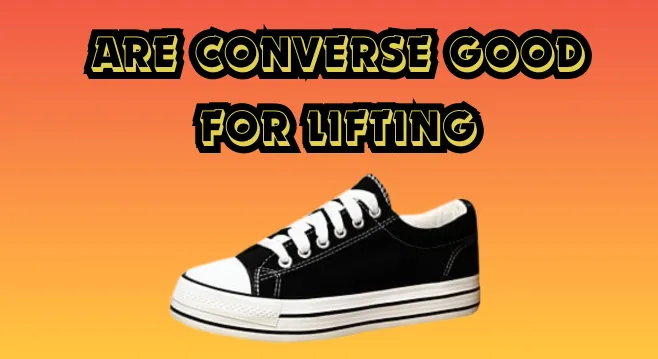Hey there, fitness enthusiast! If you’re someone who loves hitting the gym and pushing your limits, you’ve probably wondered about the best footwear for your workouts. And if you’re a fan of the iconic Converse sneakers, you might be curious if they’re a good choice for lifting weights.
Well, my friend, let’s dive into this topic and explore whether Converse shoes are suitable for your lifting sessions or not.
The Pros and Cons of Lifting in Converse
First things first, let’s talk about the pros of wearing Converse for lifting. These sneakers have been around for decades, and they’ve become a cultural icon in their own right. Their classic design and minimalist approach make them incredibly versatile, allowing you to rock them both inside and outside the gym.
One of the biggest advantages of Converse for lifting is their flat, non-compressible sole. This feature provides a solid base for your feet, which is crucial when you’re handling heavy weights. A stable foundation can help you maintain proper form and balance, reducing the risk of injury during lifts like squats, deadlifts, and overhead presses.
Additionally, the low-top design of Converse sneakers allows for greater ankle mobility, which can be beneficial for certain exercises that require a deep squat or a wide stance. This freedom of movement can help you achieve better depth and engage the right muscle groups more effectively.
However, it’s important to acknowledge the potential downsides of using Converse for lifting as well. These sneakers lack the specialized features found in dedicated weightlifting shoes, such as elevated heels, which can improve your positioning and leverage during squats and Olympic lifts.
Furthermore, Converse sneakers offer minimal arch support and cushioning, which can be an issue for individuals with pre-existing foot or ankle problems. Prolonged use during intense lifting sessions may lead to discomfort or even injury if you have specific foot-related concerns.
Lifting Shoes vs Converse: What’s the Difference?
Now, let’s compare Converse sneakers to specialized weightlifting shoes to understand the key differences.
Weightlifting shoes are designed specifically for the demands of heavy lifting. They typically feature a raised heel, which helps maintain an upright torso position and increases the range of motion in your ankles during squats and other leg exercises. This can translate to better depth and improved leverage, potentially allowing you to lift more weight.
Additionally, weightlifting shoes often have a wider, more stable base, providing greater stability and grip on the floor. This can be particularly beneficial for lifts that involve significant lateral movement, such as sumo deadlifts or wide-stance squats.
On the other hand, Converse sneakers, while offering a solid foundation, lack these specialized features. Their flat soles may not provide the same level of support and stability as weightlifting shoes, especially for advanced lifters or those with specific biomechanical needs.
Making the Right Choice
So, are Converse good for lifting? The answer is: it depends.
If you’re a beginner or recreational lifter who enjoys the versatility and style of Converse sneakers, they can certainly be a viable option for your lifting sessions. Their flat soles and low-top design can provide a decent foundation and allow for decent mobility, which may be sufficient for your current level of training.
However, as you progress in your lifting journey and start pushing heavier weights or focusing on more advanced techniques, you may want to consider investing in a pair of dedicated weightlifting shoes. These specialized shoes can provide the necessary support, stability, and leverage to help you lift more efficiently and reduce the risk of injury.
Ultimately, the choice between Converse and weightlifting shoes comes down to your personal preferences, lifting goals, and any specific biomechanical needs you may have. It’s always a good idea to listen to your body and make adjustments as necessary to ensure a safe and productive lifting experience.
FAQs: Common Questions About Lifting in Converse
To wrap up this article, let’s address some frequently asked questions (FAQs) about using Converse for lifting:
Can I wear Converse for squats and deadlifts?
Yes, you can wear Converse for squats and deadlifts, particularly if you’re a beginner or recreational lifter. However, as you progress and start lifting heavier weights, you may want to consider transitioning to weightlifting shoes for better support and stability.
Are Converse good for Olympic lifting?
While Converse can provide a decent foundation for Olympic lifts like the snatch and clean & jerk, they may not offer the same level of support and leverage as specialized weightlifting shoes. For advanced Olympic lifting, weightlifting shoes are generally recommended.
Can Converse cause foot or ankle pain during lifting?
Converse sneakers lack dedicated arch support and cushioning, which can potentially lead to discomfort or even injury for individuals with pre-existing foot or ankle problems. If you experience pain or discomfort, it’s advisable to switch to a more supportive shoe or consult a healthcare professional.
How long can I use Converse for lifting before needing to replace them?
The lifespan of Converse sneakers for lifting depends on various factors, such as the intensity and frequency of your workouts, as well as your lifting style. Generally, you may need to replace them every 6 to 12 months, or sooner if you notice excessive wear or lack of support.
Can I wear Converse for other gym activities besides lifting?
Absolutely! Converse sneakers are versatile and can be worn for various gym activities, such as cardio, bodyweight exercises, or even certain group fitness classes. However, for high-impact activities or exercises that require specialized footwear, it’s best to use shoes designed specifically for those purposes.
conclusion
Remember, the key to a safe and effective lifting experience is finding the right balance between personal preferences, lifting goals, and proper equipment. Don’t be afraid to experiment and make adjustments as needed to ensure your workouts are both enjoyable and productive.

